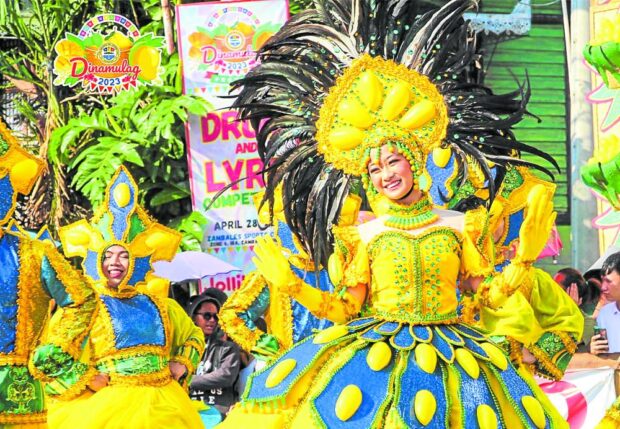
BURST OF COLOR | Street dancers take center stage during the Zambayle Street Dance Parade and Competition in front of the Zambales’ provincial capitol in Iba town on April 29,2023. It was the highlight of the Mango Festival in Zambales which celebrates the bountiful harvest of the sweet “dinamulag” variety from April 23 to May 5, 2023. (CONTRIBUTED PHOTO)
SAN ANTONIO, Zambales, Philippines — After a three-year pause due to pandemic restrictions, the annual Mango Festival in Zambales went full blast recently with the revival of crowd-drawing activities, including the grand float parade.
Street dancers clad in mango-inspired costumes performed their best moves to impress judges and spectators who traveled to this Central Luzon province to witness the celebration. The street dancing competition was the highlight of the revelry that lasted for two weeks to boost the local mango industry, which took the spotlight in 1995 when the Guinness Book of World Records cited mangoes grown here, especially the carabao or “dinamulag” variety, as the world’s sweetest.
Organizers and local officials said the resumption of the festival was aimed at helping local tourism bounce back from the impact of COVID-10.
“Indeed, this year’s festival created a stronger bond among various sectors in terms of planning and implementing activities and programs that require a whole-of-community approach,” Gov. Hermogenes Ebdane Jr. said in a statement on Tuesday.
Culture, traditions
He said the event was “another testament of the unity of Zambaleños and their will to bring out the best in each other.”
Ebdane said the festival helped the province showcase its local culture and traditions.
Among the festival’s activities were the first Philippine Mango Derby Open House, Luzon Mango Congress, Parayawan Agri-Tourism Showcase and Trade Fair, the Binibining Zambales Pageant, drum and lyre performances, a musical concert and a shooting competition.
The parade, dubbed “Zamba-Liwanag,” featured float entries from Zambales towns, as well as national agencies, schools, business establishments and community groups.
Float designs depicted the abundant harvest of mangoes in the province and the unique attractions, heritage and traditions of Zambales.
Major events concluded on April 30, but a series of mango-picking activities targeting visitors are still ongoing on some farms in the province until May 5.